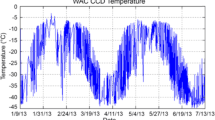Abstract
The Reuven Ramaty High-Energy Solar Spectroscopic Imager (RHESSI) observes solar hard X-rays and gamma-rays from 3 keV to 17 MeV with spatial resolution as high as 2.3 arc sec. Instead of focusing optics, imaging is based on nine rotating modulation collimators that time-modulate the incident flux as the spacecraft rotates. Starting from the arrival time of individual photons, ground-based software then uses the modulated signals to reconstruct images of the source. The purpose of this paper is to convey both an intuitive feel and the mathematical basis for this imaging process. Following a review of the relevant hardware, the imaging principles and the basic back-projection method are described, along with their relation to Fourier transforms. Several specific algorithms (Clean, MEM, Pixons and Forward-Fitting) applicable to RHESSI imaging are briefly described. The characteristic strengths and weaknesses of this type of imaging are summarized.
Similar content being viewed by others
References
Alexander, D. and Metcalf, T. R.: 1997, Astrophys. J. 489, 422.
Aschwanden, M., Schmahl, E. J. and the RHESSI Team: 2002, Solar Phys., this volume.
Aschwanden, M., Fletcher, Sakao, Kosugi, T., and Hudson, H. S.: 1999, Astrophys. J. 517, 977.
Cash, W.: 1979, Astrophys. J. 228, 939.
Cornwell, T. J.: 1984, in J. A. Roberts (ed.), Indirect Imaging, Proc. IAU/URSI Symp., Cambridge University Press, Cambridge, p. 291.
Crannell, C. J.: 1994, American Institute of Aeronautics and Astronautics: Washington DC, AIAA-94–0299.
Crannell, C. J., Hurford, G. J., Orwig, L. E., and Prince, T. A.: 1986, SPIE Proc. 571, 142.
Curtis, D.W. et al.: 2002, Solar Phys., this volume.
Datlowe, D. W.: 1975, Space Sci. Instrument. 1, 389.
Durouchoux, P., Hudson, H., Hurford, G., Hurley, K., Matteson, J., and Orsal, E.: 1983, Astron. Astrophys. 120, 150.
Enome, S.: 1982, Adv. Space Res. 2/11, 201.
Fivian, M., Hemmeck, R., Mchedlishvili and Zehnder, A.: 2002, Solar Phys., this volume.
Gull, S. F. and Skilling, J.: 1984, IEE Proc. 131, 646.
Högbom, J. A., 1974: Astron. Astrophys. 15, 417.
Hurford, G. J. and Curtis, D.: 2002, Solar Phys., this volume.
Kilner, J. R. and Nakano, G. H.: 1989, SPIE Proc. 1159, 27.
Kosugi, T. et al.: 1991, Solar Phys. 136, 17.
Lin, R. et al., 2002: Solar Phys., this volume.
Makishima, K. et al.: 1977, in K. A. van der Hucht and G. Vaiana (eds.), New Instrumentation for Space Astronomy, Pergamon Press, New York.
Mertz, L. N., 1967: Microwave Research Institute Symposia Series, Proc. Symp. on Modern Optics 17 Polytechnic Institute of Brooklyn, New York, p. 277.
Mertz, L. N., Nakano, G. H., and Kilner, J. R.: 1986, J. Opt. Soc. Am. 466, 585.
Metcalf, T. R. et al., 1996: Astrophys. J. 466, 585.
Murphy, M. J.: 1990, Nucl. Instr. Methods Phys. Res. A290, 551.
Ohki, K. et al.: 1982, Proc. Hinotori Symp. Solar Flares, ISAS, Tokyo, Japan, p. 102.
Prince, T. A., Hurford, G. J., Hudson, H. S., and Crannell, C. J.: 1988, Solar Phys. 118, 269.
Puetter, R. C., 1995: Int. J. Image Systems Technol. 6, 314.
Sato, J.: 1998, Ph.D. Thesis, NAO.
Sato, J., Kosugi, T., and Makishima, K.: 1999, Publ. Astron. Soc. Japan 51, 127.
Schmahl, E. J. and Hurford, G. J.: 2002, Solar Phys., this volume.
Schwartz, R. et al.: 2002, Solar Phys., this volume.
Sivia, D. S.: 1996, Data Analysis, a Bayesian Tutorial, Clarendon Press, Oxford.
Schnopper, H. W., Thompson, R. I., and Watt, S.: 1968, Space Sci. Rev. 8, 534.
Schnopper, H. W. et al.: 1970, Astrophys. J. 161L, 161.
Smith, D.M. et al., 2002, Solar Phys., this volume.
Van Beek, H. F., Hoyng, P., Lafleur, B., and Simnett, G. M.: 1980, Solar Phys. 65, 39.
Zehnder, A. et al.: 2002, SPIE Proc. 4853, in press.
Author information
Authors and Affiliations
Rights and permissions
About this article
Cite this article
Hurford, G., Schmahl, E., Schwartz, R. et al. The RHESSI Imaging Concept. Sol Phys 210, 61–86 (2002). https://doi.org/10.1023/A:1022436213688
Issue Date:
DOI: https://doi.org/10.1023/A:1022436213688




